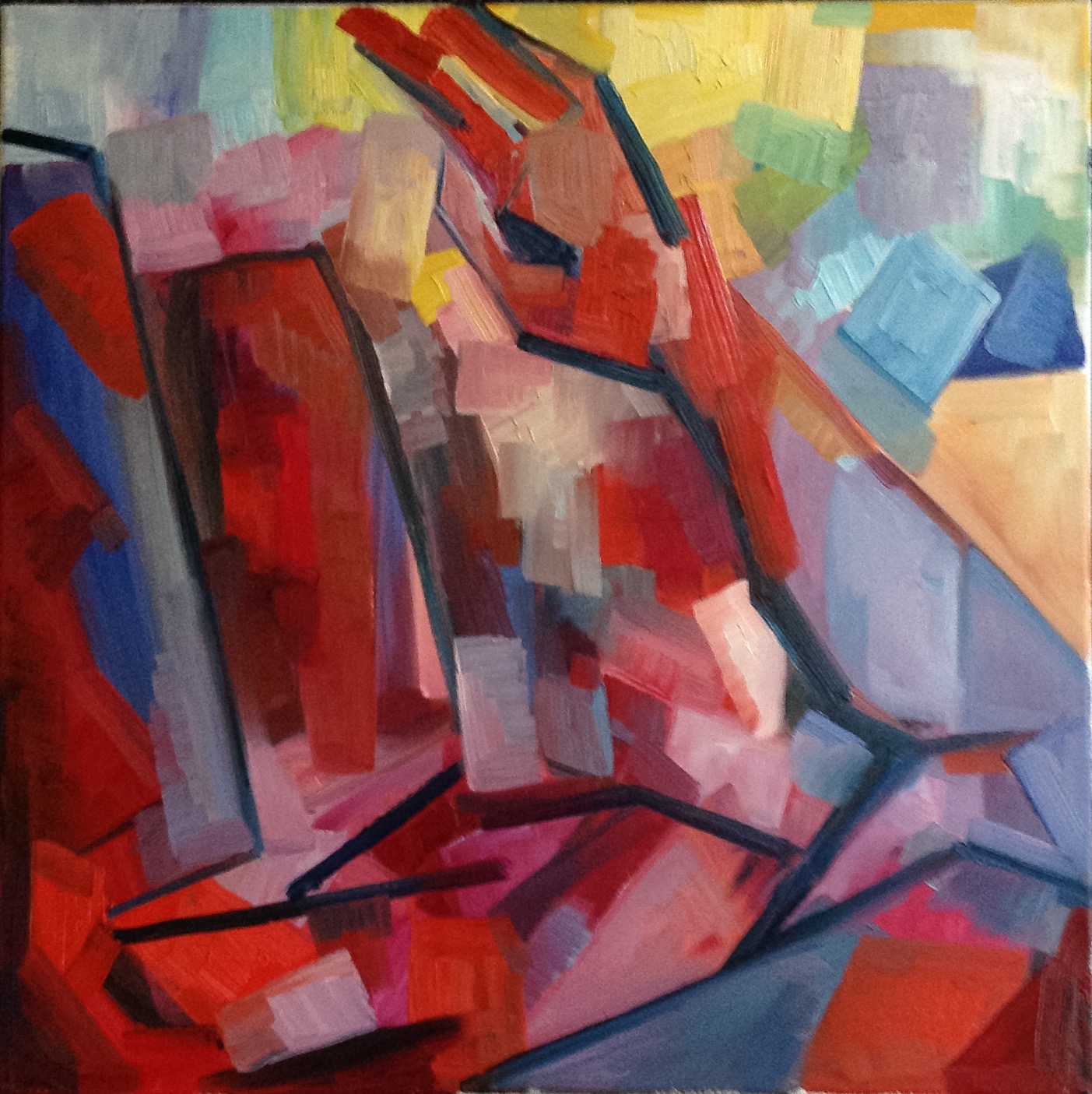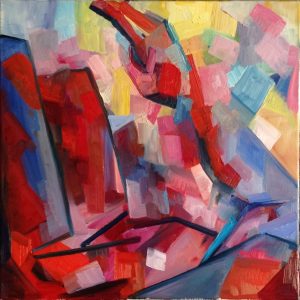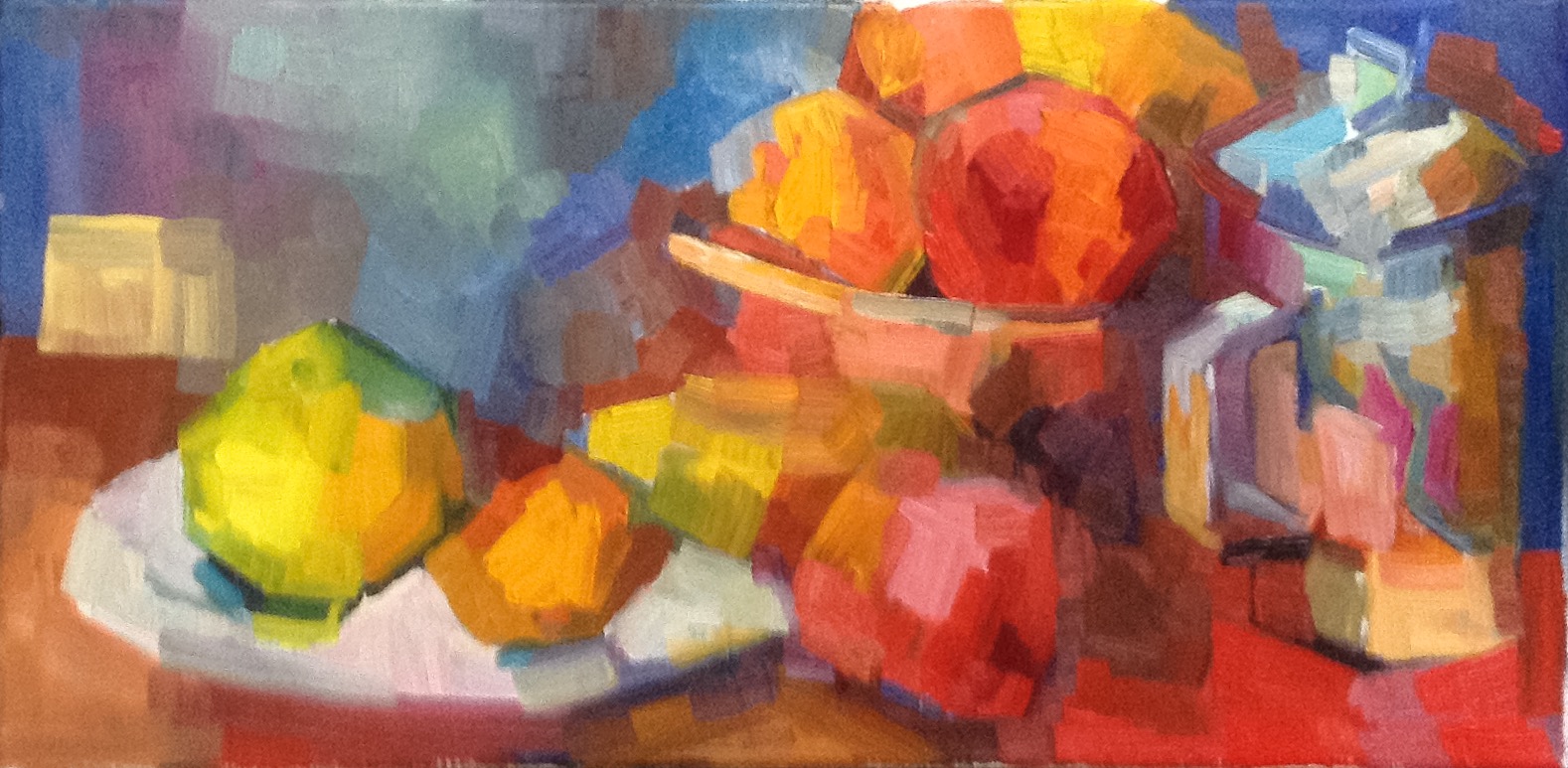
Was it the proud full sail of his great verse,
Bound for the prize of all too precious you,
That did my ripe thoughts in my brain inhearse,
Making their tomb the womb wherein they grew?
Was it his spirit, by spirits taught to write
Above a mortal pitch, that struck me dead?
No, neither he, nor his compeers by night
Giving him aid, my verse astonished.
He, nor that affable familiar ghost
Which nightly gulls him with intelligence,
As victors of my silence cannot boast;
I was not sick of any fear from thence:
But when your countenance filled up his line,
Then lacked I matter; that enfeebled mine.William Shakespeare. Sonnet 86
June 6-7, 2016
This is the last painting in this nine-sonnets collage. The Shakespearean tradition refers to these, not without some justification, as the “rival poet(s)” sonnets. But this theme, albeit obviously present in the sonnets, is just an opening into the depth of stuff much more fundamental to the experience of art.
The approach I have chosen for this series sonnets splits it, with some degree of randomness, into fourteen compositions, fourteen “chapters” of a story. About a year ago, already fully immersed in the series, I realised that the title of each chapter ought to follow the pattern “The paradox of X”. And right now, as I am writing this down, I realise that the whole series might be called “Paradoxes of love”. Or “Fourteen paradoxes of love”.
There is a certain ring of truth to this idea of the sonnets series as a sequence of paradoxes, unresolvable puzzles of human condition. But I didn’t have this kind of title for this, on-going, chapter, not till is very end. I called it, for myself, “Poet and Muse”. Now, the title is “Paradox of Muse”.
Since this is the last painting, it has to complete the overall composition. The sonnet contains, in a sense, a summary of the whole nine-sonnets subsequence, and ends in a complete breakdown of “matter” (then lacked I matter). In the future painting, I imagine, it is represented as a cubist-like breakdown of form. The colour harmony is largely determined by the painting’s role in the composition: it leans towards reds, to complement the others. This is a very abstract, very vague vision, but it’s a beginning.
The sonnet continues the previous sonnet’s theme: the challenge is not the very existence of someone else’s great verse (or great paintings, as it happens), but the suspicion that the experience you have to express is already expressed, so there is nothing to be added. This reminded me of something Lidia Chukovskaya once said: that being a younger contemporary of Anna Akhmatova prevented her from becoming a poet — not because of Akhmatova’s great verse, but because it was filled with shared experiences.
June 8, 2016
By this morning, I somehow had the image for this painting in my mind: a figure, lying on the back, with raised knees, with the head towards the viewer (almost perpendicular to the picture plane). The details are vague. I might need some figure drawing of reclining nudes to go forward.
June 10, 2016
I am still struggling with the composition, the pose — still no idea where it comes from, what it is about, where should I look for the source for this pose.
June 12, 2016
There was a long waking period this night, marked by a new experience in meditation. It’s an experience of a well-lit space rushing towards me, almost about to drown me in itself — somewhat dizzying. I tend to flinch when something unexpected like this happens in meditation, to resist the experience, but I (almost) didn’t this time.
And I finally understood the pose, the figure in the painting which I’ve been desperately trying to see more clearly: this is the pose of a person who sees him/herself, lying (probably at night — there are repeated references to nighttime in the sonnet). So what I need is to study myself in this position, with both the knees (in the background), and the hand/arm — closer to the foreground — within the square picture plane. It also means there is no head in the picture (one doesn’t see one’s own head), so the head ought to be “cut off” by the edges of the painting.
I also realised that the future composition is organised around a grand triangle, with side edges along the legs and the hand/arm, and saw some glimpses of blood-like red brushstrokes. The way these paintings are emerging in my field of vision feels as though each painting already exists, and my only challenge is to see it — at least enough to start painting it.
June 13, 2016

The first day of painting. The composition is established and, structurally, it seems to work with other paintings of the collage.
There are things that came up in while contemplating the painting, but are still not present — or not present enough — on the canvas: the cubist treatment of space and form, the dissolution of matter; the blood-like bright-red brush-strokes, the barely visible hints at the motives of earlier sonnets (sail in particular). But the triangular composition seems to work, and the motive of hand rhymes with the first sonnet of the collage.
As I was painting today, suddenly a poem by Boris Pasternak floated to the surface of my consciousness (the link above goes to a rough translation, but the original is there, too). It’s about how he didn’t know just how serious this whole thing — art, poetry — would turn out to be in the end, in his old age — how Art would be over, and Soil and Fate would be breathing in his lines instead. I felt as though that I am approaching the moment, where this experience becomes genuinely true for me, where I know what he meant — where my life is at stake. Can this be that this motive is present in this sonnet, too?
Whatever it was, it was really frightening, but I felt like I was ready to face it, to take it as it comes. For now, it’s just me and this painting — today was a good start, but there is a lot of work ahead.
June 14, 2016

It seems that I’ve brought the painting to the stage where I don’t really what to do with it. At some level, it seems complete. At another, it needs clarification, simplification, cleaning up of colours.
June 15, 2016

Working on strengthening the triangular essence of the composition, and the tension between contours, colour, and the dissolution of “matter”.
The lack of matter, combined with a dreamy vision of one’s own body in reclining position. The painting comes close to the vision, but there is a lot of work to do. The angularity of the composition need to be strengthened and some of its reds, muted.
I painted less today than I thought I would — there was a slowness to the process, some lack of clarity — I didn’t really know what to do. Or, to be more precise, there were intermittent moments of clarity in the midst of uncertainty. Could it be that the theme of the sonnet gets itself involved in my painting process?
June 16, 2016
I’ve decided to let the sonnet painting dry a bit today — there was no way I could do what needed to be done on the surface this wet.

So my studio time went into a small (20”x10”) painting from life, a still life with a Chinese cup.
I really needed to paint from life today — as a way to reconnect with reality. I don’t know whether I will return to this painting later on, or maybe I’ll just scrape it away, and start something new on this canvas. In this case, the meaning was fully in the painting-as-process, and I have no idea whether the result can turn into a painting-as-thing. The intention was pure connection — painting what I see, not what I know; not reconstructing anything, not aligning anything, just pure impressions. A novel object in the still life — the Chinese cup — introduced to intensify the process with a new challenge, and also as a way to understand the Dutch flowers experience better (they loved using Chinese vases for their flowers).
June 17, 2016
The eighty sixth sonnet painting is complete, which completes the whole composition, “The paradox of Muse”. Most likely, there will be more work, once the paintings are arranged together as a collage — there usually is, but they have to dry a bit first anyway. At this point, I don’t think there will be much to do, though, since I’ve been constantly looking at them together while painting, but I’ll have to look at them afresh in a couple of months.
Looking back at the long months of work on this composition, I see some themes I didn’t anticipate — the rhythm of hands, the interplay of circles and triangles. The painting experience has also shifted in the process — I am now better at paying attention to the flow of thoughts emerging in response to the painting, at really listening of what I want to tell myself.
I used to think of this flow of thoughts as a distraction, the product of “monkey mind” — and, in many respects, it was (and, occasionally, still is). But I’ve learned this “mind hack”, which is as counterintuitive as almost any other “mind hack” — instead of following the temptation to trying to shut up this stream of partly verbalised thoughts (which usually doesn’t work anyway), the really needed mental gesture is a shift towards attentive listening. Once I concentrate on listening, the non-sensical or unrelated mental noise fades away, and if something remains, it is usually worth listening to and directly relevant to what I am doing.